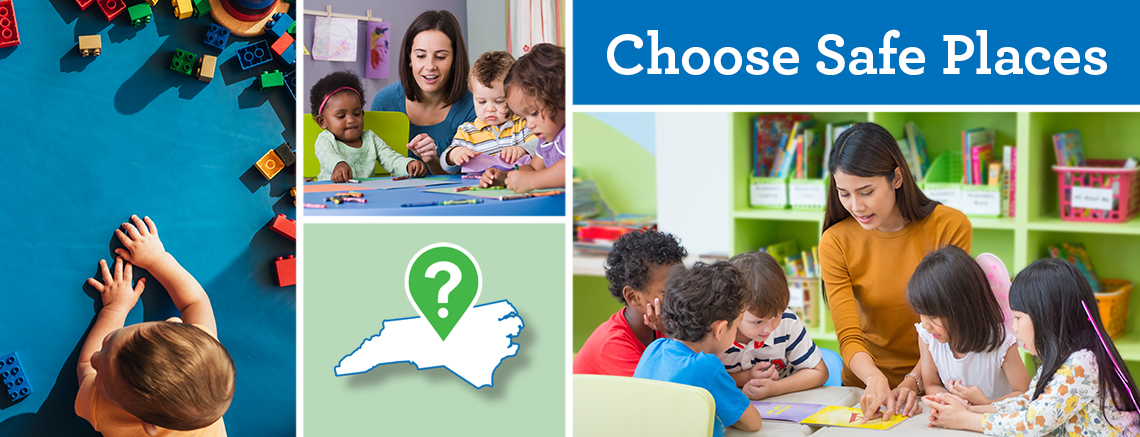Epidemiology: Occupational and Environmental
Choose Safe Places: For Providers

Many children spend large amounts of time in child care facilities, making it important to take action to make these spaces safe from harmful substances.
The Choose Safe Places (CSP) program is part of a national initiative to protect children from harmful exposures to chemicals while attending child care centers.
The CSP program works with child care providers to ensure child care centers are located in areas free of harmful substances, such as lead, arsenic, or volatile organic compounds.
Four Key Elements to Consider for an Environmentally Safe Child Care Location
[+] Expand All Items Below | [-] Contract All Items Below
1. Former uses of the site
Contaminants can stay on a site long after the activities that caused the contamination have stopped.
Knowing what a property was used for in the past will help identify potential contaminants. For example, a building where manufacturing occurred may be contaminated or a property used as a landfill could have chemicals in soil or water. Just because a property was used for something previously does not mean it is not suitable for a child care center, but these situations should be further evaluated.
Lead is a common contaminant in older buildings because lead paint was commonly used until it was banned in 1978.
Helpful Resources
- Division of Waste Management Site Locator Tool: The NC Department of Environmental Quality’s Site Locator Tool is an interactive map that provides access to currently available information about hazardous waste sites.
- Local Officials: Local tax or geographic information system (GIS) offices may have property records that may help identify past use of a site. Additionally, local zoning and planning offices may have information on a property’s history.
2. Migration of harmful substances from nearby properties
Chemicals can sometimes move through the air, water, and soil to neighboring buildings or properties, so it is important to observe nearby sites and activities that might create environmental exposures. Hazardous waste sites, dry cleaners, nail salons, and gas stations are some potential nearby activities to be aware of.
Additionally, sometimes chemicals can travel through groundwater and then volatilize, or become gases, and enter buildings or homes above. This is known as vapor intrusion, and some of these chemical vapors can be harmful when present in indoor air.
Helpful Resources
- Division of Waste Management Site Locator Tool: The NC Department of Environmental Quality’s Site Locator Tool is an interactive map that provides access to currently available information about hazardous waste sites.
- US Environmental Protection Agency: The US Environmental Protection Agency has information on what vapor intrusion is and how it may impact you.
- Agency for Toxic Substances and Disease Registry: The The Agency for Toxic Substances and Disease Registry has information on vapor intrusion and what to expect during a vapor intrusion investigation.
3. Presence of naturally occurring harmful substances
Naturally occurring contamination comes from substances already in the environment, rather than from chemicals or other hazardous materials used or manufactured by humans. Radon is one of those naturally occurring contaminants. Radon seeps into homes from the rock under the building’s foundation.
In addition, arsenic and other metals can occur naturally. These metals may be present in soil or groundwater and may require further evaluation.
Helpful Resources
- North Carolina Radon Program:The NC Department of Health and Human Services’ Radon Program has information on how to test for radon, ordering test kits, how to mitigate radon, and an interactive map of radon testing throughout the state.
4. Access to safe drinking water
Drinking water that is piped into your home, school, or office comes from either a public water supply or a private well. Knowing about issues that can affect water quality is important for good health. Lead, nitrate, and bacteria are common water contaminants that can affect children’s health.
Public water systems are regulated by state and federal laws to ensure drinking water safety. You can find out more about what’s in your water system from your Consumer Confidence Report.
Unlike public water systems, the protection and maintenance of private wells are the responsibility of the owner. We at the Division of Public Health recommend testing for common well concerns, such as nitrate, arsenic, and bacteria. Also make sure you follow the Division of Child Development and Early Education regulations for your facility.
Helpful Resources
- DEQ Public Water Supply: The NC Department of Environmental Quality has information on public water supplies throughout the state.
- Well Water and Health: Provides information on maintaining a private well, including testing and potential well water contaminants.
Get Started!
Evaluate your potential child care center location using this property checklist.
If you have questions about completing this checklist or other questions about Choose Safe Places, please contact the Occupational & Environmental Epidemiology Branch at (919) 707-5900 or nchace@dhhs.nc.gov.
If you have other questions about the child care licensing process, please contact the Division of Child Development and Early Education at (919) 814-6300.
Additional Resources
- The NC Children’s Environmental Health Unit has information on their Child Care Sanitation Program and Childhood Lead Poisoning Prevention Program.
- The Children’s Environmental Health Network (CEHN) works to promote healthier environments for children. Their Eco-Healthy Child Care Program provides training and best practices for creating a healthy child care environment.
- The Agency for Toxic Substances and Disease Registry (ATSDR) provides further information about the nationwide Choose Safe Places for Early Care and Education initiative.
- The Environmental Protection Agency (EPA) has resources for identifying and reducing children’s exposures to harmful substances in child care facilities.
- Choose Safe Places Fact Sheet (PDF)
- Choose Safe Places for Providers: Cleaning, Sanitizing and Disinfecting Resources
Last Modified: March 2, 2022
